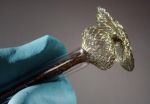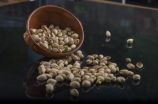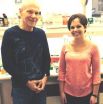(Press-News.org) Jena (Germany) A trousers button, a coin or a watch can be dangerous for people with a nickel allergy. Approximately 1 in 10 Germans is allergic to the metal. "This raises the question of the safety of medical implants containing nickel," explains Professor Dr. Markus Rettenmayr of the Friedrich Schiller University Jena (Germany). Nickel-titanium alloys are increasingly used as material for cardiovascular implants in minimal invasive surgery. Once implanted, nickel-titanium alloys can release small amounts of nickel due to corrosion phenomena, the holder of the Chair of Metallic Materials explains. Our concern was that this could - in particular over a long period of time - lead to a nickel contamination in the patient's body that possibly results in health problems.
But these concerns are essentially unfounded: The team of Jena scientists led by Professor Rettenmayr and his colleague Dr. Andreas Undisz report in the current issue of the scientific journal 'Acta Biomaterialia' that the release of nickel from wires made of nickel-titanium alloys is very low, also over longer periods of time. The scientists could back up their statement in the first long-term study ever, which examined such nickel release in detail: The testing period for metal release, as requested for governmental approval of a medical implant, is only a few days. In contrast the Jena research team monitored the release of nickel over a time period of eight months.
Examination objects were fine wires from a superelastic nickel-titanium alloy that are, for example, applied in the form of occluders (these are medical implants used for the correction of a defective cardiac septum). Such occluders often consist of two tiny wire-mesh "umbrellas", approximately the size of a 1 Euro coin. The superelastic implant can be mechanically drawn into the shape of a thin thread, which then can be placed in a cardiac catheter. "By that means the occluders can be put into place via minimal invasive surgery," Dr. Undisz says. Ideally the implant will stay in the patient's body for years or decades.
Dr. Undisz and the doctoral candidate Katharina Freiberg wanted to find out what happens during this period of time with the nickel-titanium wire. They exposed samples of the wires, which underwent different mechanical and thermal pre-treatment, to highly purified water. They then examined the release of nickel according to pre-defined time intervals. "This wasn't trivial at all", Undisz says, "because the concentration of the released metal is often at the limit of detection." However, in co-operation with scientists from the Institute for Clinical Chemistry and Laboratory Medicine of the Jena University Hospital the materials scientists successfully developed a reliable test routine to measure the process of the nickel release.
"Mostly in the first days and weeks, depending on the pre-treatment of the material, considerable amounts of nickel may get released," Undisz summarizes the results. According to the materials scientist this is due to the mechanical strain of the implant during the surgery. "The deformation damages the thin layer of oxide covering the material. As a consequence the initial nickel release increases." In the long run, however, the nickel release decreases to amounts of a few nanograms per day and is hence far below the amount of nickel that we absorb anyway through our food on a daily basis.
INFORMATION:
Original Publication:
Freiberg KE, Bremer-Streck S, Kiehntopf M, Rettenmayr M, Undisz A: Effect of thermomechanical pre-treatment on short- and long-term Ni release from biomedical NiTi, Acta Biomaterialia (2014), doi: 10.1016/j.actbio.2014.01.003
Contact:
Dr.-Ing. Andreas Undisz
Otto-Schott-Institut für Materialforschung
Friedrich Schiller University Jena
Loebdergraben 32, 07743 Jena
Germany
Phone: ++49 3641 947768
Email: andreas.undisz@uni-jena.de
Metal in the heart is non-hazardous to health
Materials scientists at the University of Jena examine implants made of nickel-titanium alloy in a long-term study
2014-02-18
ELSE PRESS RELEASES FROM THIS DATE:
Investment bankers lead businesses to better mergers, acquisitions
2014-02-18
BUFFALO, N.Y. – Corporations with board directors who have investment banking experience are more likely to acquire other businesses – and make better acquisitions when they do – according to a new study from the University at Buffalo School of Management.
Forthcoming in the Journal of Financial Economics, the study found that directors with investment banking experience help their firms to select better businesses to acquire, more accurately determine the value of the target business and either reduce reliance on mergers and acquisition consultants or negotiate lower ...
Molecular biology mystery unravelled
2014-02-18
The nature of the machinery responsible for the entry of proteins into cell membranes has been unravelled by scientists, who hope the breakthrough could ultimately be exploited for the design of new anti-bacterial drugs.
Groups of researchers from the University of Bristol and the European Molecular Biology Laboratory (EMBL) used new genetic engineering technologies to reconstruct and isolate the cell's protein trafficking machinery.
Its analysis has shed new light on a process which had previously been a mystery for molecular biologists.
The findings, published today ...
Personality and spaces, remaking love, meaning in life, and commonsense morality
2014-02-18
People and spaces, the tragedy of commonsense morality, myths about meaning of life, and remaking love were four themes at the Society for Personality and Social Psychology (SPSP) conference in Austin. Researchers presented new work, showing how psychology reaches into our everyday lives. Video from four of these talks is now available online.
Highlights include:
Sam Gosling of the University of Texas-Austin described how the link between our emotions and spaces is is inseparable. As such, our spaces say a lot about us. In new work, Gosling and colleagues identified ...
One-quarter of high risk patients denied anticoagulation after AF ablation
2014-02-18
Sophia Antipolis, 18 February 2014: One-quarter of high risk patients do not receive anticoagulants after ablation of atrial fibrillation (AF), according to the latest survey of European practice.
The EORP Atrial Fibrillation Ablation Pilot Study, conducted by the European Heart Rhythm Association (EHRA) of the European Society of Cardiology (ESC), reveals that 65% of patients were taking anticoagulants one year after ablation of AF.1 But up to 25% of patients at high risk of stroke (defined as a CHA2DS2-VASc score >1) were not taking any anticoagulant drug. And around ...
A new system accelerates verification of printed electronic documents
2014-02-18
This news release is available in Spanish. Researchers at the Universidad Carlos III in Madrid have designed a system that speeds up online administrative procedures by automatically verifying and validating printed electronic documents, a process that had been done manually up until now.
With the law known as Ley 11/2007, regarding citizens' electronic access to public services, going into effect, electronic documents have gained full legal validity. When a document of this type is printed out, it must be accompanied by its Código Seguro de Verificación (CSV- Secure ...
Parents are not more likely to split up if mothers earn more than fathers
2014-02-18
Couples with young children are as likely to stay together if the mother is the main breadwinner rather than the father, new research shows.
A paper published in the journal Sociology today [Tuesday 18 February 2014] says the relationships of parents are in some cases more stable if the mother earns more than the father.
Dr Shireen Kanji, of the University of Leicester School of Management, and Dr Pia Schober, of the German Institute for Economic Research, Berlin, examined survey data on 3,944 British couples as their first child aged from eight months to seven years. ...
Food & moods
2014-02-18
Emotional eating is something we're all familiar with. Maybe you had had a rough week at work and all you want on Friday night is to plop down and watch a movie with a giant bowl of buttery popcorn. Maybe you're a student stressed about a big exam and you're munching on candy as you study. Or maybe your child's birthday party is coming up and you've bought an ice cream cake to serve a small army to celebrate. Happy or sad, up or down, there's a plethora of media in the world that tells us our moods often dictate the foods we choose to eat.
More recent studies, though, ...
New treatment proposed to prevent intestinal inflammation in cancer patients
2014-02-18
Jerusalem, Feb. 18, 2014 – Experimental work pointing to a therapy for alleviating mucositis -- a common, severe side effect of chemotherapy and irradiation of cancer patients or patients prepared for bone marrow transplantation – has been achieved by an international team of researchers from the US and Israel headed by scientists at the Hebrew University of Jerusalem.
Mucositis is a strong inflammatory reaction of the mucosal lining of the digestive system, particularly the gut. Mucositis is often a major reason for premature suspension of anti-cancer therapy. As ...
Increase in Arctic cyclones is linked to climate change, new study shows
2014-02-18
Winter in the Arctic is not only cold and dark, it is also storm season when hurricane-like cyclones traverse the northern waters from Iceland to Alaska. These cyclones are characterized by strong localized drops in sea level pressure, and as Arctic-wide decreases in sea level pressure are one of the expected results of climate change, this could increase extreme Arctic cyclone activity, including powerful storms in the spring and fall.
A new study in Geophysical Research Letters uses historical climate model simulations to demonstrate that there has been an Arctic-wide ...
Saving Sochi's slopes: How artificial snow is made
2014-02-18
WASHINGTON, Feb. 18, 2014 — In what may be the warmest Winter Olympics on record, Sochi looks more like SoCal by the day. With few real snowflakes around to blanket Sochi's slopes, the latest episode of the American Chemical Society's Reactions YouTube series explains how science keeps the Winter Olympics alive with artificial snow. The video is available at http://youtu.be/ftMFMlk6FlA.
Producing artificial snow isn't as simple as grinding up big blocks of ice and spraying it on the slopes. Sochi's artificial snow guns — cannons that fire fake snow 20 to 30 feet in ...
LAST 30 PRESS RELEASES:
Tracing the quick synthesis of an industrially important catalyst
New software sheds light on cancer’s hidden genetic networks
UT Health San Antonio awarded $3 million in CPRIT grants to bolster cancer research and prevention efforts in South Texas
Third symposium spotlights global challenge of new contaminants in China’s fight against pollution
From straw to soil harmony: International team reveals how biochar supercharges carbon-smart farming
Myeloma: How AI is redrawing the map of cancer care
Manhattan E. Charurat, Ph.D., MHS invested as the Homer and Martha Gudelsky Distinguished Professor in Medicine at the University of Maryland School of Medicine
Insilico Medicine’s Pharma.AI Q4 Winter Launch Recap: Revolutionizing drug discovery with cutting-edge AI innovations, accelerating the path to pharmaceutical superintelligence
Nanoplastics have diet-dependent impacts on digestive system health
Brain neuron death occurs throughout life and increases with age, a natural human protein drug may halt neuron death in Alzheimer’s disease
SPIE and CLP announce the recipients of the 2025 Advanced Photonics Young Innovator Award
Lessons from the Caldor Fire’s Christmas Valley ‘Miracle’
Ant societies rose by trading individual protection for collective power
Research reveals how ancient viral DNA shapes early embryonic development
A molecular gatekeeper that controls protein synthesis
New ‘cloaking device’ concept to shield sensitive tech from magnetic fields
Researchers show impact of mountain building and climate change on alpine biodiversity
Study models the transition from Neanderthals to modern humans in Europe
University of Phoenix College of Doctoral Studies releases white paper on AI-driven skilling to reduce burnout and restore worker autonomy
AIs fail at the game of visual “telephone”
The levers for a sustainable food system
Potential changes in US homelessness by ending federal support for housing first programs
Vulnerability of large language models to prompt injection when providing medical advice
Researchers develop new system for high-energy-density, long-life, multi-electron transfer bromine-based flow batteries
Ending federal support for housing first programs could increase U.S. homelessness by 5% in one year, new JAMA study finds
New research uncovers molecular ‘safety switch’ shielding cancers from immune attack
Bacteria resisting viral infection can still sink carbon to ocean floor
Younger biological age may increase depression risk in older women during COVID-19
Bharat Innovates 2026 National Basecamp Showcases India’s Most Promising Deep-Tech Ventures
Here’s what determines whether your income level rises or falls
[Press-News.org] Metal in the heart is non-hazardous to healthMaterials scientists at the University of Jena examine implants made of nickel-titanium alloy in a long-term study



